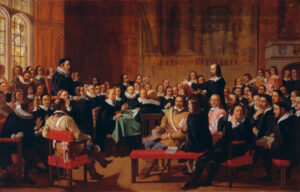In one of the most famous passages in all the Bible, Paul says that those whom God “foreknew he also predestined to be conformed to the image of his Son.” (Romans 8:29).1 In short, Scripture is clear that all who are chosen, called, justified, and will be one day gloried, will grow in Christlikeness in their Christian life. In subsequent articles, we will be looking at how, as Christians, we are pursue God through living lives of holiness and a Christian’s pursuit of holiness is actually patterned after God’s own passion for his holiness. To say it another way, God’s holiness is the pattern for our holiness. It defines how we should pursue of holiness and determines how we glorify God in lives of holiness. Thus, in pursuing Christlikeness, we imitate God and join Him in pursuing His holiness.
However, before we look at this in greater detail, we need to understand God’s own passion for His Holiness. And there are at least three aspects of God’s holiness. First, God’s holiness is his separateness from all sin and evil. This is often the first thing that comes to mind when Christians consider God’s holiness. Stephen Charnock says in his Discourse on the Existence and Attributes of God (1682) that God’s holiness is his “an abhorrency of everything contrary” to Himself. For just “as we call gold pure that is not imbased by any dross…so the nature of God is estranged from all shadow of evil.”2 The essence of God’s holiness is that his perfect nature can never be mixed with the dross of our sin. Second, if negatively God’s holiness is his separation from all sin and evil, then positively God’s holiness is His commitment to the perfection of his will. Again, Charnock, continues, God’s holiness is His “delight and complacency in everything agreeable to his will.”3 In this way, God’s holiness is devotion to Himself and all things that He loves.
Sinclair Ferguson helpfully points out that since this is true, then “to say that ‘God is love’ and that ‘God is holy’ [is] ultimately is to point to the same reality.” This is no passive devotion. Rather, God is passionately, intensely devoted to Himself. Ferguson continues by explaining that God’s holiness that that this “love that flows within the very being of God, among and between each of the three persons of the Father, Son and Holy Spirit.” One gets a sense of the intensively of God’s devotion to himself in Isaiah 6, where, one peers behind the veil into the throne room of heaven to see the angels around God’s throne in the presence “of God in his majestic holiness. However, the sheer intensity of his love cause the angels to “distance themselves, cover their faces, and be separate” for “to gaze on the sheer intensity of this flow of triune holy love would be to endanger themselves.” The closest experience in this life, Ferguson says, is that moment in a wedding when the minister, standing right in front of the new married couple that is passionately in love, says, “you may kiss the bride.” And although the rest of the guests are at a distance, the minister usually is standing in front of the couple. And often, Ferguson says, the intimacy and intensity of that moment is so profound that the minister feels compelled to look away. For encapsulated in that moment of this newly consecrated marriage is a love so intimate, so intense, so devoted to one other that one must turn aside and remove themselves from their passionate exchange.4
The third aspect of God’s holiness worth considering is that God’s holiness is put on display, this is what the Bible calls the glory of God. Building on Ferguson’s analysis of Isaiah 6, John Piper has very persuasively defined God’s glory as his holiness on display. He points out that when the angels are gathered around the throne, they do not say in verse 3, “Holy, holy, holy is the Lord of hosts; the whole earth is full of his holiness!” Rather, they say, “Holy, holy, holy…the whole earth is full of his glory!” As Piper says, when the radiant beauty of “God’s holiness shines into creation, it is called ‘God’s glory.’” Thus, the display of God’s holiness is the breaking forth of “God’s infinite worth and beauty,” “His ultimate value and excellence,” and the undeniable fact that He is indeed “the supreme reality in the universe.” And therefore, the Bible calls this breaking forth of God’s holiness to the world—the displaying of the glory of God.5 As we will see, this view of God’s glory and holiness, has radical implications for how we think about glorifying God through living lives of holiness.
[1] This article is an expand and updated version of one section of Greg Salazar, “Growing in Christ-likeness,” in Joel R. Beeke, ed., Growing in Grace (Grand Rapids: Reformation Heritage Books, 2020).
[2] Stephen Charnock, The Works of Stephen Charnock, 5 vols. (Edinburgh: Banner of Truth, 2010), 2:194.
[3] Charnock, Works, 2:194.
[4] Sinclair B. Ferguson, Devoted to God: Blueprints for Sanctification (Edinburgh: Banner of Truth Trust, 2016), pp.2–3.
[5] John Piper, Reading the Bible Supernaturally: Seeing and Savoring the Glory of God in Scripture (Wheaton, IL: Crossway, 2017), pp.43, 46



